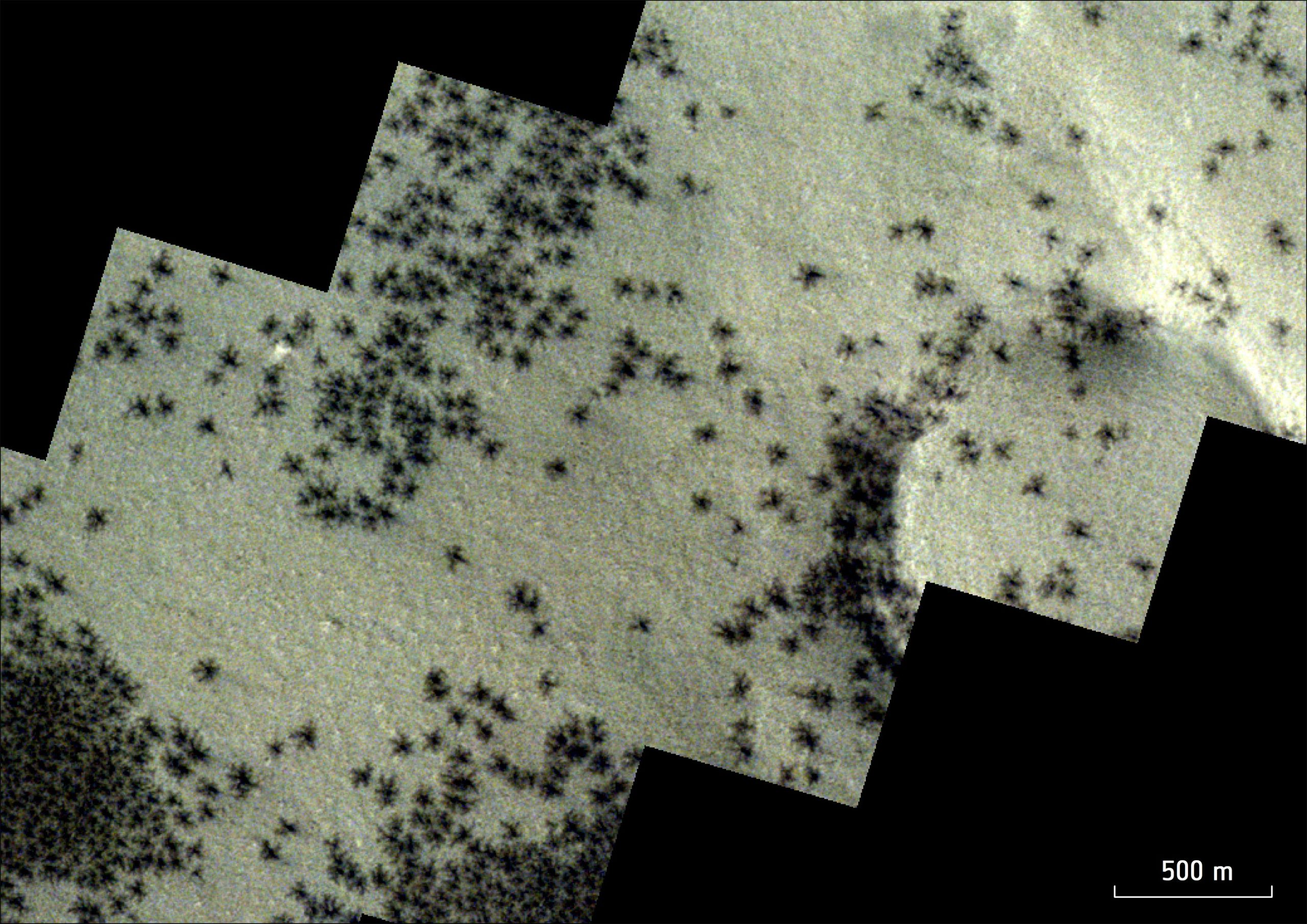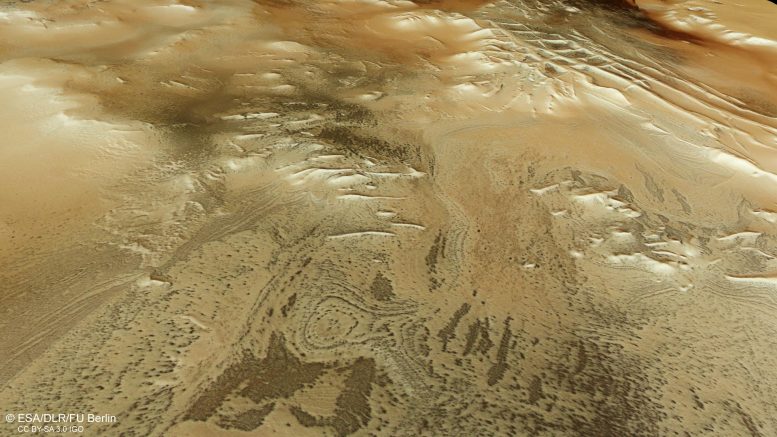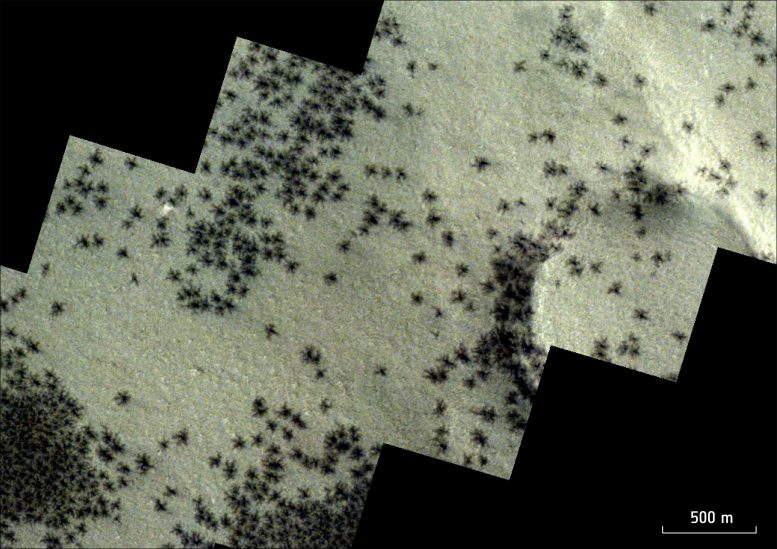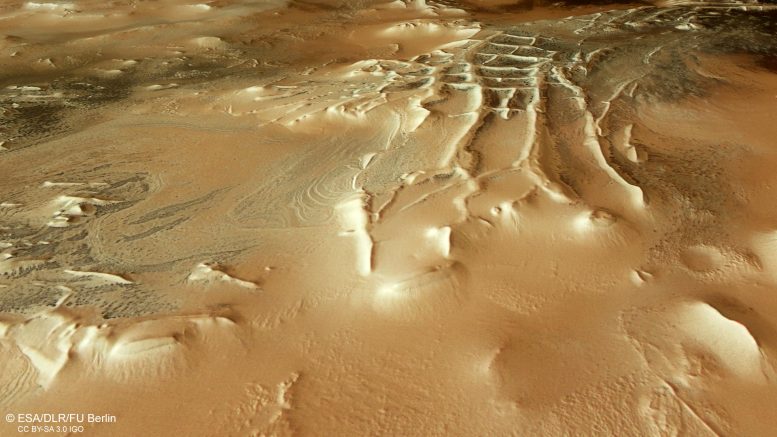
The dark spots in this image from the European Space Agency's Mars Express are a clear sign of “spiders” spread across Mars' south polar region. These tiny features form when carbon dioxide gas heated in sunlight penetrates the overlying ice sheets, carving branching grooves into the surface and pulling dark material to the surface to form dark spots.
Many of these spots can be seen within the dark region on the left of the image, which lies on the outskirts of the part of Mars nicknamed the Inca City. The reason for this name is obvious, as the linear, almost geometric network of hills is reminiscent of Inca ruins.
Source: ESA/DLR/FU Berlin
the European Space Agency's Mars Express has captured clear traces of 'spiders' spread across Mars' south polar region.
Rather than being actual spiders, these tiny, dark features form when spring sunlight falls on layers of carbon dioxide deposited during the dark winter months. Sunlight causes the carbon dioxide ice at the bottom of the layer to turn into gas, which later accumulates and penetrates the overlying ice sheets. The gas explodes freely in the spring on Mars, pulling dark material to the surface as it moves, breaking up layers of ice up to a meter thick.

This oblique perspective overlooks the part of Mars nicknamed the Inca City (formally known as the Labyrinth of Angustus). The reason for this is no mystery, as the linear network of hills is reminiscent of Inca ruins. Traces of features known as “spiders” can be seen. These small, dark features form when carbon dioxide gas, heated in sunlight, penetrates the overlying ice sheets. Source: ESA/DLR/FU Berlin
The emerging gas, laden with dark dust, shoots out through ice cracks in the form of tall fountains or geysers, before retreating and settling on the surface. This creates dark spots between 45 meters and 1 kilometer across. This same process creates distinctive “spider-shaped” patterns etched beneath the ice, so these dark spots are a clear sign that spiders may be lurking below.
Another ESA Mars rover, the ExoMars Trace Gas Orbiter (TGO), has clearly imaged tendril-like patterns of spiders (see below). The spiders captured by TGO are located near, but outside, the area shown in this new Mars Express image. The Mars Express view shows dark spots on the surface formed by escaping gas and material, while the TGO perspective also captures the spidery, web-like channels carved into the ice below.

This image shows features known as “spiders” near Mars' south pole, as seen by the CaSSIS (Color Surface and Stereo Imaging System) instrument aboard ESA's ExoMars Trace Gas Orbiter.
These features form when spring sunlight falls on layers of carbon dioxide deposited during the dark winter months. Sunlight causes the carbon dioxide ice at the bottom of the layer to heat up and turn into a gas, which then accumulates and penetrates the overlying ice sheets. The emerging gas, laden with dark dust, shoots through ice cracks in the form of tall fountains or geysers, before retreating and settling on the surface, creating dark spots. This same process creates distinctive “spider-shaped” patterns etched beneath the ice: the same patterns shown here.
Source: ESA/TGO/CaSSIS
The aforementioned dark spots can be seen throughout the Mars Express image, creeping across towering hills and rolling plateaus. However, most of them can be seen as small specks in the dark region to the left, which lies on the outskirts of the part of Mars nicknamed the Inca City. The reason for this name is not a mystery, as the linear, almost geometric network of hills is reminiscent of Inca ruins. The Inca city, officially known as the Angostos Labyrinth, was discovered in 1972 by… NASAMariner 9 probe.
This new view of the Inca city and its hidden arachnid inhabitants was captured by Mars Express' high-resolution stereo camera. A version with stickers is also available; Click on the image below to explore the area and find out more about the different features you can see here.

This oblique perspective shows a portion of Mars nicknamed the Inca City. The reason for this is no mystery, as the linear, almost geometric network of hills is reminiscent of Incan ruins. The Inca city, officially known as the Angustus Labyrinth, was discovered in 1972 by NASA's Mariner 9 probe. Source: ESA/DLR/FU Berlin
Mysterious origin
We're still not sure exactly how the Inca city formed. It is possible that the sand dunes turned to stone over time. Materials such as magma or sand may seep through broken plates of Martian rock. Or ridges could be meandering structures associated with glaciers.
The Inca city “walls” seem to delineate part of a large circle with a diameter of 86 kilometers. Scientists therefore suspect that the “city” is located inside a large crater that itself formed when a rock from space collided with the surface of the planet. This impact likely caused faults to spread across the surrounding plain, which then filled with rising lava and has since eroded over time.

This color-coded topographic image shows a slice of the terrain in Mars' south polar region. It features an area nicknamed the Inca City (officially called Angustus Labyrinthus), which features linear hills reminiscent of Inca ruins, and traces of small, dark features known as “spiders.” These are formed when carbon dioxide gas heated in sunlight penetrates the overlying ice sheets.
This view was created from data collected by ESA's Mars Express on February 27, 2024, and is based on a digital terrain model of the area, from which the topography of the landscape can be extracted. The lower parts of the surface appear in blue and violet, while the higher areas appear in white and red, as shown on the scale at the top right.
Source: ESA/DLR/FU Berlin
In the central part of the image the scene changes somewhat, with large round and oval swirls creating an effect reminiscent of marble. This effect is thought to occur when layered sediments erode over time.
To the right of the center of the frame are a few prominent steep, flat-topped ridges and ridges that rise more than 1,500 meters above the surrounding terrain. These ridges are formed when soft materials are eroded over time by wind, water, or ice flows, leaving behind the hard materials that make up these ridges.
Towards the right (north) the ground becomes increasingly covered with fine, light-coloured dust. Some signs of spiders can be seen spread across the plateaus here, lurking among the various gullies and basins.

This stereo image shows a region near the south pole of Mars in 3D. The area features the Angostos Labyrinth (a part of Mars nicknamed the “Inca City” due to its linear hills) and traces of dark creatures known as “spiders.” Created from data captured by the High Resolution Stereo Camera (HRSC) on ESA's Mars Express spacecraft on February 27, 2024. The anaglyph provides a 3D view when viewed with red-green or red-blue glasses. Source: ESA/DLR/FU Berlin
Mars exploration
Mars Express has revealed a lot about Mars in the past two decades and counting. The orbiter continues to image the surface of Mars, map its minerals, explore the composition and circulation of the atmosphere, probe beneath its crust, and study the Martian environment.
The spacecraft's HRSC showed us everything from… Wind-sculpted hills and canyons Into the gaps on the flanks of massive volcanoes to impact craters, tectonic faults, river channels and ancient lava pools. The mission has been extremely productive throughout its life, creating a fuller and more accurate understanding of our planetary neighbor than ever before.





More Stories
NASA Close to Deciding What to Do With Boeing’s Troubled Starliner Spacecraft
Physicists propose a method for mechanical detection of individual nuclear decays
Real Scientists Lived on Fake Mars in a Texas Shed for a Year